SAIGON
We again flew on Vietnam Airlines from Hue to Saigon. Ok, we know that it is now called Ho Chi Minh City, but everybody still calls it Saigon, so we do too. We were again met at the airport by a guide and driver and taken to our hotel – the Rex.
The Rex Hotel is best known as the hotel where most foreign journalists stayed during the Vietnam war. For the press corps, it was a convenient location right in the center of the city, and it was considered a relatively safe location because of its proximity to the palace. It is now also a very noisy location. We got off to a rather rough start with the Rex over our room, and it was not settled to our satisfaction. So, although we enjoyed some aspects of the hotel, we would not recommend it. But that is where we were booked for a few nights, so we would make the best of it and get out and see Saigon.
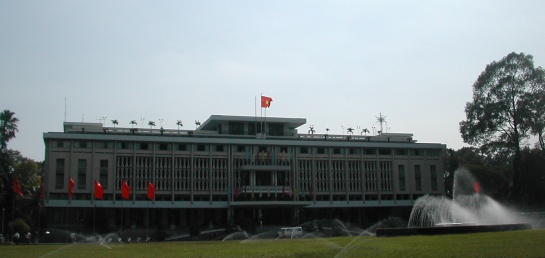
Reunification Palace
Our guide, Tai, told us our first stop would be the Giac Lam Pagoda. Oh please – no more pagodas… But we went quietly, and it was worth seeing. This pagoda – now a temple – was built in 1744, and it is believed to be the oldest in Saigon. It was different from those we saw in Hanoi and Hue, and we are glad we saw it. But no more pagodas for a few days, please.
This is a huge market in China Town. It is three stories tall and covers what seems a few city blocks. Everything imaginable is sold here including literally millions of pairs of rubber slippers. We surely did not see it all, but we saw enough to be impressed.
This is a large museum in a beautiful building dating back to 1929. There are two main display areas. One section covers Vietnamese history from the first human vestiges (somewhere around 500,000 years ago) until the foundation of the Democratic Republic of Vietnam on September 2, 1945. The second area displays special subjects reflecting characteristics of southern Vietnam and other Asian countries such as Buddha statues, ceramics, stone sculpture, Champa art, and ethnic minorities in southern Vietnam.
The exhibits are arranged in seventeen ‘stations’. It is intended that tours will be self-guided, and it is to find one’s way through. Exhibits labels are multilingual.
Although we enjoyed the museum, and we learned a lot about the natural history of what is now Vietnam, we thought that there were too many reproductions. We would prefer to see fewer exhibits and more authenticity. Reproductions were used to fill in too many blanks. But this is a worthwhile museum nonetheless.
This was a frank and brutal documentary of the horrors of the Vietnam War with the US. There were numerous exhibits including artillery pieces, prisoner cages, land mine victims, and Agent Orange victims. However, the exhibit that touched us most was one of photos.
There is an exhibit titled “Requiem” that is a collection of photos taken by 134 war reporters killed in Vietnam. The photographers that shot the pictures in this one exhibit are all dead – all killed while on assignment in Vietnam. This is a very small sample of what photographers saw there, but it is a very moving sample. Many photos were taken from cameras after the photographer was killed – their last roll of film. A very moving exhibit in a well done museum.
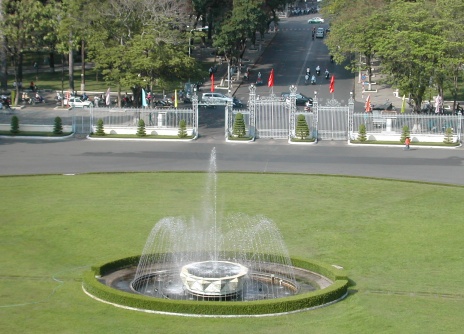
The gates through which the tanks crashed
This building was built in 1966 to serve as South Vietnam’s Presidential Palace. It is through the gates of this palace that the first communist tanks crashed on April 30, 1975 – the day that Saigon surrendered. The gates have been repaired. Otherwise, the building has been left as it was in 1975.
One can follow a guide through the palace or take a self-guided tour. We did a bit of both. It is a lovely building, albeit 30 years dated in décor. Most of the palace is open to visitors, and we were most interested in the basement.
The basement contains the war room, map room, communications rooms, sleeping rooms, and other compact reinforced work areas. The communications equipment still in place seemed especially dated.
As you are leaving the basement, there are small rooms where a film is repeatedly shown in multiple languages. We went in to watch “Independence Palace – Witness to History”. It was scathing. We had been trying to learn more about the Vietnamese perspective of the war, and we learned a lot here. This is not recommended for those sensitive to national criticisms. It was educational but harsh.
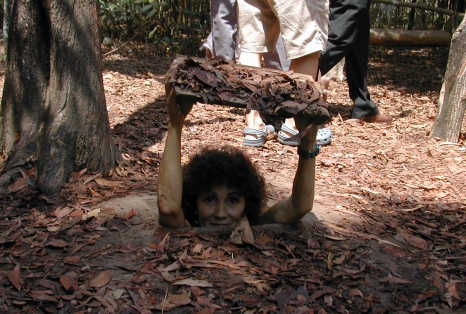
Nita squeezing down in to tunnel
The Cu Chi Tunnels are a system of subterranean tunnels reaching from Cambodia to Saigon. There are more than 125 miles of tunnels, and their depths range from 10 to 40 feet. These tunnels were built during the war with the US, and they enabled the Viet Cong to move about undetected underground.
Deep within the tunnel system, there are meeting rooms, schools, military production facilities, and kitchens. Some would spend weeks underground in the tunnels.
Despite great camouflage efforts, the US eventually discovered the tunnels and targeted them with ground operations. The Viet Cong persevered. Subsequently the US turned their bombers on the area and transformed it into a moonscape. Numerous B-52 craters remain all around the tunnels.
Parts of the tunnel system have been rebuilt and are open to visitors – to small visitors. Bud would not fit through the first opening through which he tried to enter the tunnels, but he did fit through another. Once inside, he remained hunched over and both shoulders rubbed the sides of the tunnel. He was glad to come back out. Nita would fit through the entrance, but she was too claustrophobic to enter. These are very small passages, and it is difficult to imagine spending any amount of time in the tunnels.
The tunnels are also remarkably well camouflaged. Vertical shafts that drop down to a tunnel are well covered by brush. Air vents are through termite mounds. Cooking smoke is diffused through a system of vents. It is a remarkable system.
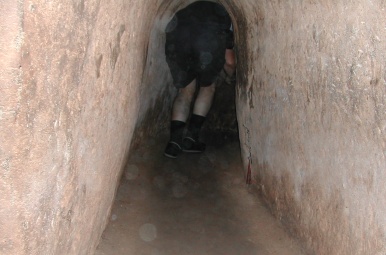
The view inside the Cu Chi tunnels the butt of the bent-over person ahead of you
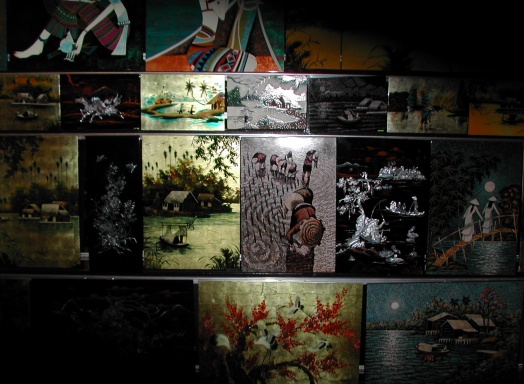
Some lacquerware on display
On the drive back from the tunnels, our guide wanted to stop at the Government Handicraft Center. He said that the employees here all have some handicap related to the war – most related to Agent Orange. The government trains then employs them to make laquerware. He thought we might like to see their work.
Our American cynicism flared up, and we somewhat expected them to want something from us – probably money. Instead we found a group of highly trained artisans producing very fine lacquerware. Our guide did remind us that all employees were handicapped – that was obvious from the countless damaged limbs – but there was no effort to evoke sympathy. Rather, we felt admiration for artisans that produce such nice work.
We were pleased to find a piece small enough to fit on the boat, and we bought it. It cost $13 (yes, their work really is that inexpensive at the factory), and we did not bargain. We were pleased to give them their asking price. Maybe we should have given them more than $15…
We walked around Saigon a lot, and we got caught in one downpour. Most of what we ate was good, and we especially enjoyed the soups and breads. We enjoyed Saigon, but it is a very big city, and we were ready to move on.
We crossed town to My Tho to board the river boat that would take us around the Mekong Delta and up the Mekong River. Time to slow our pace a bit.
Follow us to the Mekong Delta and River or jump ahead to Cambodia.